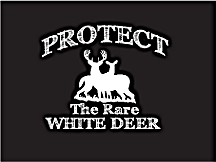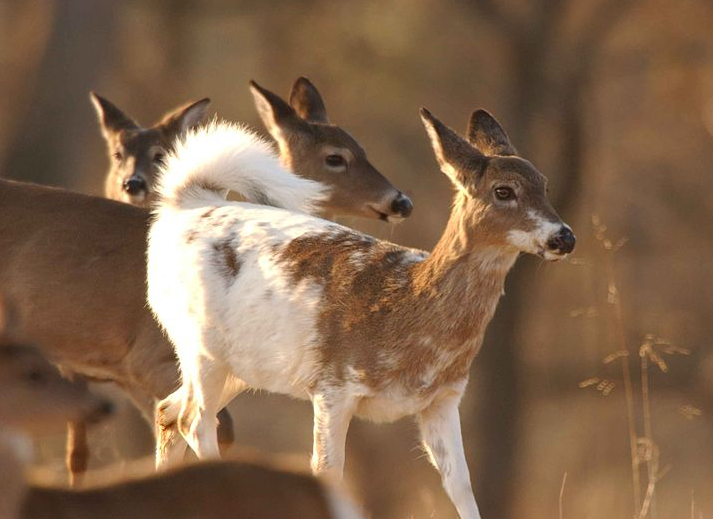
Math, Myth, and the Piebald Deer

A piebald fawn with normal-colored herdmates. Photo: U.S. Fish and Wildlife Service – Wikimedia Commons.
Piebalds, we are told, are supposed to be much more common than white or albino deer, but perhaps an oft-cited number makes them a little more common than they really are…
Read any story on piebald deer and somewhere in the article the writer will state authoritatively that “piebalds occur in 2%, or less than 2%, of the deer population.” For anyone that stops to think about that number though, that’s an amazingly high statistic.
If 2% of all deer are piebalds, that would mean that 2 out of every 100 deer, or 1 in 50, have a mixed coat of brown and white. That is very hard to believe. Even if many of those piebalds died as fawns, which happens to fawns of any color, 2% is still a very high number.
In the Leland area, where cervid hooves traverse every wooded bluff and field, 1 in 50 would mean a piebald deer could be found grazing around every bend in the road. How come, then, most people here have never seen a piebald deer? White ones, maybe, but not piebalds.
And a word here on the definition of piebald: this is not referring to a pure white deer with a tiny spot of brown or black. The word piebald typically describes an animal with patches of brown or black mixed with white (think pinto horses). Even small amounts of either white or brown could qualify a deer to be a piebald, but a single spot is really stretching the definition.
The definition of piebald is so misunderstood that even now it is amazing to read how many times a hunter shoots a white deer with brown staining on the head and argues that it had “brown on it” and was therefore a piebald and legal to shoot. It is even more amazing when wardens or judges dismiss a charge for the same reason. (See these Illinois, Wisconsin, and Michigan stories.)
In truth, the brown color on the head and hind legs of a white deer is about as natural as the stains on a pair of white pants after a backyard football game.
Bucks produce oily secretions from glands on their foreheads that cause staining, especially when the deer rubs its head and antlers against young saplings during the rut. Tarsal glands, visible as dark brown pads on each hind leg, also create staining on the leg hairs when the deer urinates. Both areas carry scent, even in does and fawns.
So, what is going on? Why is the 2% number so prevalent and so often quoted? If very few people are seeing piebalds, and the white deer with brown staining don’t qualify, then where does that 2% number come from?
What is soon evident when looking for information on white and piebald deer is how little research has been done on their numbers. Even the game departments of most states have not kept track of coat color for hunter kills, even though it would have been easy to do at deer registration stations.
There is one exception, though, which is described in the book Whitetail Intrigue: Scientific Insights for Whte-tailed Deer Hunters by John Ozoga. On page 139 of the book John refers to a study done by Michigan DNR biologist, Larry Ryel, who searched for abnormal individuals in the Michigan deer herd from 1959 to 1961.
The vast majority of the 35,986 deer Ryel surveyed were hunter kills, but Ryel used other sources as well to find abnormal deer, including “DNR files, museum collections and various publications.” He admits his study wasn’t totally random, but the very large sample size made it a credible study.
Out of the 35,986 deer Ryel studied, he found only two albinos, which translates to 1 in 17,993 deer. This is relatively close to the 1 in 20,000 occurrence most commonly quoted for white and albino deer. It is also close to the percentage of albinos in the human population, so this statistic seems pretty reasonable.
Ryel also found 24 piebalds in his study (those “ranging from a few white spots to mostly white with a trace of brown“). Looking at the results by area, “(the) incidence of partly white deer for those three years averaged 0.02% in Upper Michigan and 0.08% in Lower Michigan.”
Now, this is where the picture starts going wrong. The number 0.02 does equal 2%, but the Upper Michigan number of piebald deer was not 0.02; it was 0.02%. Percents have to be further divided by 100 to get their decimal equivalent, so 0.02% really equals 0.0002 or 2 out 10,000, and 0.08% equals 0.0008 or 8 out of 10,000. That translates to 1 piebald in 5000 deer in the first case, and 1 in 1250 deer in the second case. This is a far cry from the commonly proclaimed “2%” or 1 in 50.
So, did somebody (or a lot of somebodies) misread 0.02% at one time and no one has cross-checked or corrected it since? Is everyone simply quoting everyone else without referring to Ryel’s statistics? This is, after all, no small error, since the misread percent is 100 times greater than the original number.
There may be different sources to refute this assertion, but unless corroborating statistics come up, it does look like a misread decimal point created a “fact” (or “factoid” in modern parlance) that is still echoing through articles and news stories today. White deer (and piebalds) have always been surrounded by myths, but it may be that some of the modern myths are the biggest myths of all.

